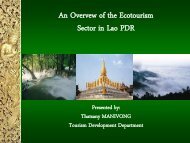GEOLOGY OF THE PENGKALAN HULU-BETONG TRANSECT ...
GEOLOGY OF THE PENGKALAN HULU-BETONG TRANSECT ...
GEOLOGY OF THE PENGKALAN HULU-BETONG TRANSECT ...
Create successful ePaper yourself
Turn your PDF publications into a flip-book with our unique Google optimized e-Paper software.
22<br />
may be concluded that the age of the Kroh formation/Betong Formation (SDkr/bt) is<br />
ranging from Early Silurian to Devonian.<br />
In Thailand, many fossil assemblages, i.e. Tentaculites elegans and Tentaculites sp.<br />
occur in light pink shale strata and limestone lenses. Conodonts assemblage found in<br />
chert beds indicate the age of rock sequence is Devonian. However, the discovery of<br />
graptolite in light pink shale suggests the age of the succession is possibly Silurian-<br />
Devonian. Therefore, the succession of the Kroh formation/Betong Formation (SDkr/bt)<br />
can be dated as Silurian-Devonian age.<br />
Depositional environment<br />
The widely spread argillaceous facies with considerable amount of carbonaceous<br />
content suggests that the deposition of this rock unit occurred in the euxinic marine<br />
environment. Fine-grained materials indicate long distance transportation and the<br />
deposition took place in a quite and undisturbed environment. The absence of benthos<br />
fossils and bioturbation indicates that the deposition occurred in deep marine<br />
environment. The calcareous facies and arenaceous facies with subordinate conglomerate<br />
might be deposited in the continental shelf, the relatively shallower part of the<br />
depositional basin.<br />
3.1.2 The Kubang Pasu/Yaha Formation (Ckp/yh)<br />
In Malaysia, The Kubang Pasu Formation (Ckp) is conformably underlain by the Kroh<br />
formation (SDkr) and it is conformably overlain by the Gerik formation (Pgk). The term<br />
Kubang Pasu Formation was introduced by Jones (1981) for a sequence of thick<br />
sandstone and thin shale in the Kedah and Perlis areas in northwest peninsular Malaysia.<br />
The stratigraphic name was taken after the Kubang Pasu District, Kedah where he first<br />
discovered the good outcrops of this rock unit. The same lithological unit is observed to<br />
extend eastwards into the Transect area.<br />
In Thailand, the Yaha Formation (Cyh) is conformably underlain by the Betong<br />
Formation. The term Yaha Formation was introduced by Nakapadungrat et al. (1988) to<br />
describe a sequence of thick Carboniferous clastic sequence in the Sadao-Yala area. It is<br />
named after Yaha District, where geological information was first studied and good<br />
outcrops were available.<br />
Distribution<br />
In Malaysia, the Kubang Pasu/Yaha Formation (Ckp/yh) is well exposed in the northeast<br />
Kedah State, and in UpperPerak State in the central part of the Transect area. The rock<br />
exposures in northeast Kedah can only be observed along the streams i.e. Sungai Teliang<br />
which located in the remote and forested area (Figure 12). The only access to that area is<br />
by boat via Muda Lake, a man-made lake for the paddy field irrigation in Kedah State,<br />
then preceed to continue the traverse by foot. In UpperPerak, good outcrops can be easily<br />
observed along the border security road parallel to the Malaysia-Thailand border on the<br />
Malaysian side known as FELDA Nenering area, Pengkalan Hulu, Perak. The Kubang<br />
Pasu/Yaha Formation (Ckp/yh) underlies most of the Kerunai Malay Reserve area,<br />
extending from the Bukit Kobeh (Khao Ko Be) area along the Malaysia-Thailand border<br />
in the north to the Padang Sembai-Kubang Gondang area in the south. It is also well<br />
exposed along the East-West Highway up to Banding Island, northeast Perak where this<br />
rock unit is locally metamorphosed to metasandstone, phyllite and schist. Minor



